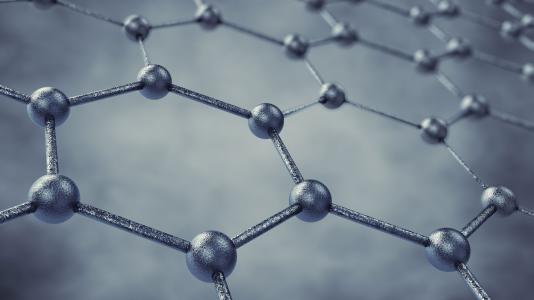
Scientists at the U.S. Department of Energy’s Argonne National Laboratory have recently discovered that they could substitute one-atom-thick graphene layers for either solid- or oil-based lubricants on sliding steel surfaces, enabling a dramatic reduction in the amount of wear and friction.
Graphite is a commonly used solid lubricant. However, it works best in moist air and does not protect the surface from tribo-corrosion. New studies led by Argonne materials scientists Anirudha Sumant and Ali Erdemir show that single sheets of graphite, called graphene, work equally well in humid and dry environments. Furthermore, the graphene is able to drastically reduce the wear rate and the coefficient of friction (COF) of steel. The marked reductions in friction and wear are attributed to the low shear and highly protective nature of graphene, which also prevents oxidation (tribo-corrosion) of the steel surfaces when present at sliding contact interfaces.
Stainless steel in the form of ball bearings forms an integral part of many moving mechanical machines, ranging from table fans to giant wind turbines.
“Reducing energy and materials losses in these moving mechanical systems due to friction and wear remains one of the greatest engineering challenges of our time,” Sumant said.
Current lubricants, such as molybdenum disulfide or boric acid, have disadvantages such as environmentally unfriendly additives, or are environmentally unfriendly themselves. The oil-based lubricants need to be consistently reapplied, producing additional waste. The cost of applying solid lubricant coatings is rather high and, due to finite thickness, they do not last very long and must be reapplied thus increasing cost.
On the other hand, a graphene coating can be applied to the surface simply by dipping the surface into a solution containing a very small amount of graphene. The graphene was found to adhere strongly to the surface during the testing. It is interesting to see that even partial coatings are very effective at reducing friction because of the ability of the graphene to reorient itself during initial wear cycles, and can last a considerable length of time providing a low friction during sliding. Additionally, they do not produce any waste.
“Graphene offers a cost-effective, high-performance solution to a number of problems conventionally associated with mechanical systems,” Erdemir said. “Hence graphene might be the new best solid lubricant, as none of the other known solids can reduce friction and wear as effectively.”
Sumant and Erdemir estimated that the reduced loss of energy to friction offered by new materials would yield a potential energy savings of 2.46 billion kilowatt-hours per year, equivalent to 1.5 million barrels of oil.
“Applying or reapplying the graphene coating does not require any additional processing steps other than just applying small amount of solution on the surface of interest, making this process simple and cost-effective,” said Diana Berman, a postdoctoral researcher at Argonne’s Center for Nanoscale Materials (CNM).
“It is interesting to see how a one-atom-thick material affects the properties at a larger scale,” Sumant said. “I believe that graphene has potential as a solid lubricant in the automotive industry and, once fully developed, it could have positive impacts on many mechanical applications that could lead to a tremendous savings of energy.”
Sumant is associated with Argonne’s CNM, while Erdemir works for Argonne’s Energy Systems Division. Funding came from Argonne’s Laboratory-Directed Research and Development office.
The team recently published their findings in two consecutive papers in the high-impact journal Carbon.
More information: D. Berman, A. Erdemir, A.V. Sumant: Few layer graphene to reduce wear and friction on sliding steel surfaces. Carbon, 54, 454-459 (2013)
D. Berman, A. Erdemir, A.V. Sumant: Reduced Wear and Friction Enabled by Graphene Layers on Sliding Steel surfaces in Dry Nitrogen, Carbon, in press.
Argonne National Laboratory seeks solutions to pressing national problems in science and technology. The nation’s first national laboratory, Argonne conducts leading-edge basic and applied scientific research in virtually every scientific discipline. Argonne researchers work closely with researchers from hundreds of companies, universities, and federal, state and municipal agencies to help them solve their specific problems, advance America’s scientific leadership and prepare the nation for a better future. With employees from more than 60 nations, Argonne is managed by UChicago Argonne, LLC for the U.S. Department of Energy’s Office of Science.
The Center for Nanoscale Materials at Argonne National Laboratory is one of the five DOE Nanoscale Science Research Centers (NSRCs), premier national user facilities for interdisciplinary research at the nanoscale, supported by the DOE Office of Science. Together the NSRCs comprise a suite of complementary facilities that provide researchers with state-of-the-art capabilities to fabricate, process, characterize and model nanoscale materials, and constitute the largest infrastructure investment of the National Nanotechnology Initiative. The NSRCs are located at DOE’s Argonne, Brookhaven, Lawrence Berkeley, Oak Ridge and Sandia and Los Alamos National Laboratories. For more information about the DOE NSRCs, please visit http://science.energy.gov/bes/suf/user-facilities/nanoscale-science-research-centers/.